Incontinence Advice
Treatment for stress incontinence: What are my options?
Are you noticing leaks whenever you laugh, sneeze, cough or move in a certain way? These could be signs of stress incontinence – one of the most common types of urinary incontinence. The good news is that there are many ways to manage and treat it.

In this article, MoliCare® will walk you through the different treatment options for stress incontinence, what causes the condition, how it’s diagnosed, and what you can expect from each type of treatment – whether it’s something you can try at home or with medical support.
Key points
- Stress incontinence is caused when pressure is placed on the bladder.
- Treatments include pelvic floor exercises, lifestyle and behaviour adjustments and surgical procedures.
- Surgery is available if other options don’t work.
- Simple daily changes can improve bladder control over time.
- A proper diagnosis is key to finding the right treatment for you.
- Both men and women can experience stress incontinence, although the causes may differ.
Treatment for stress incontinence
- Symptoms of stress incontinence
- Who is most likely to experience stress incontinence?
- Five key management options for stress incontinence
- Lifestyle changes
- Pelvic floor muscle training
- Non surgical devices and injections
- Sex and stress incontinence
- Support from HARTMANN Direct
- Preparing for your appointment
- FAQs
- Sources
Symptoms of stress incontinence
Choosing the right treatment begins with recognising the symptoms. Stress incontinence typically involves unintentional leaks triggered by physical exertion or abdominal pressure. Typical triggers include:
Coughing or sneezing – the sudden jolt forces a few drops out.
Lifting or bending – picking up a child or a heavy bag can set it off.
Exercise – running, jumping, or even brisk walking may cause wet patches.
Standing from a chair – that quick change in position squeezes the bladder.
Any effort that tenses the core – such as laughing fits, pushing a lawnmower, or a tough yoga pose.
If you also notice urgent ‘got-to-go’ moments, you could have mixed incontinence (a combination of stress and urge incontinence). An accurate diagnosis by a healthcare professional will confirm what’s happening and steer you in the right direction towards the best treatment for stress incontinence.
Who is most likely to experience stress incontinence?
While stress incontinence can affect anyone, it is significantly more common in women due to gender-specific factors, such as:
Pregnancy – the growing foetus adds pressure to the pelvic floor muscles.
Childbirth – the stretching of tissues during vaginal delivery can weaken pelvic floor muscles and damage supportive structures. Sometimes, these tissues don’t fully recover, especially after multiple births.
Menopause – falling oestrogen levels can reduce the strength and elasticity of the tissues that support the urethra, increasing the risk of leakage.
Pelvic organ prolapse – when pelvic organs shift from their normal position (often after childbirth), pressure on the bladder can lead to incontinence.
For more detailed guidance about these topics, read the following guides:
Although less common, men can also develop stress incontinence. In most cases, this occurs after medical procedures or due to injury or illness, such as:
Prostate surgery – a common cause in men, especially after surgery for prostate cancer, which can weaken or damage the sphincter muscle.
Radiation therapy – this treatment for prostate or rectal cancer can sometimes irritate or damage surrounding tissue and nerves, leading to leakage during movement or exertion.
Some risk factors are not specific to gender and can contribute to stress incontinence in both men and women:
Weakened pelvic floor muscles – ageing, inactivity or chronic straining can reduce muscle tone, making it harder to contain urine under pressure.
Chronic coughing or heavy lifting – conditions like asthma, chronic bronchitis or ongoing constipation create frequent abdominal pressure, wearing down pelvic support over time.
Obesity – excess body weight places constant pressure on the bladder and pelvic floor.
Nerve damage – diabetes, spinal injuries or neurological conditions such as multiple sclerosis can interfere with the bladder’s ability to store urine properly.
If you notice leakage when coughing, lifting or exercising, don’t ignore it. Speaking to a healthcare professional or continence specialist can help identify the cause and recommend treatment options tailored to your needs.
Remember: Stress incontinence is not an inevitable part of ageing. With the right treatment, many people can reduce or even eliminate symptoms.

Five key management options for stress incontinence
Like most forms of incontinence, simple changes can be made yourself before you even visit your healthcare professional. Whilst it is still best to play it safe and discuss lifestyle changes with them first, they will likely recommend the following options:
1. Lifestyle changes
Lifestyle adjustments often form the first line of stress incontinence treatment because they cost nothing and carry no risk. Small changes can have a big impact. Try:
Avoid bladder irritants – such as coffee, fizzy drinks or alcohol.
Spread drinks evenly through the day – cut fluids two hours before bed.
Timed toilet trips – concerned about how many times a day you should wee? Visiting the toilet every two to three hours can reduce urgency.
Switch to low-impact exercise – such as walking or swimming – that keeps you fit without jarring the bladder.
Maintain a healthy weight – even modest weight loss reduces pressure on the bladder.
Combining two or three of these changes can lead to a noticeable improvement within weeks.
Could stress be affecting you in other ways? Find out more about common stress indigestion symptoms.

2. Pelvic floor muscle training (Kegels)
Strong pelvic muscles support the bladder and urethra. Regular Kegel exercises are a cornerstone of stress incontinence management. You can carry out Kegel exercises by:
Finding the right muscles – if you can stop your urine mid-flow, you have identified the right muscles; however, don’t carry out the exercises when passing urine.
Squeezing and lifting for three seconds, then relaxing for three – Repeat this ten times.
Building up to squeezing for ten seconds, then relaxing for ten seconds – Repeat this set three times a day.
If you would like more information about the technique, read our guides about strengthening the pelvic floor for women, as well as Kegel exercises for men.
For a tailored approach, a physiotherapist or continence nurse can guide you and track progress.

3. Non-surgical devices and injections
For those with substantial incontinence, where lifestyle adjustments have not worked or are not appropriate, the following non-surgical treatments may be recommended by a healthcare professional:
Vaginal pessary – a soft silicone ring placed inside the vagina pushes the urethra upward, preventing leaks during a cough or gym class. It can be self-inserted in the morning and removed before bed. Alternatively, some types of pessaries are inserted by healthcare professionals and remain in place for a number of months before being replaced.

4. Sex and stress incontinence
Leaks during sex can affect confidence, but don’t let it impact your relationship. You can:
Empty your bladder beforehand.
Use discreet absorbent pads.
Choose positions that reduce abdominal pressure.
Communicate openly with your partner.
Kegels can also improve sexual confidence and control.
Learn about managing incontinence at night for those who are concerned with nighttime urination.

5. Support from HARTMANN Direct
Managing leaks while you work toward long-term control is easier with the right protection. We at HARTMANN Direct provide MoliCare® adult incontinence products including:
Dermatologically tested products – kind to your skin.
Discreet and highly absorbent – maintaining your privacy and locking away odours fast.
A wide variety of products in different shapes and sizes – guaranteeing you will find the best product to meet your needs.
Eco-friendly, washable incontinence underwear – offering comfort and sustainability without compromising on protection.
Our high-quality products allow you to carry on with daily life while following your stress incontinence treatment plan.
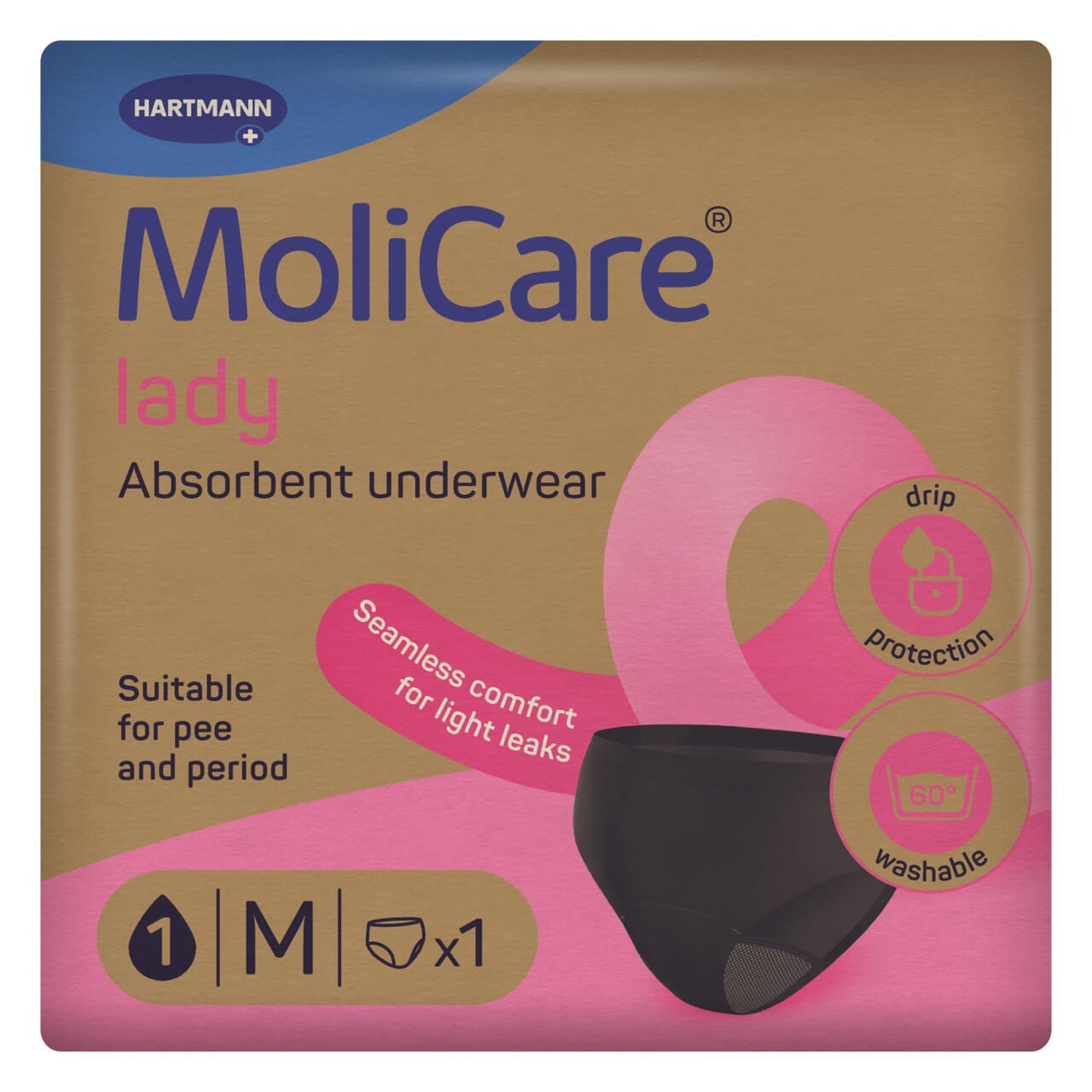
Preparing for your appointment
Maximise your consultation time by coming prepared.
What to bring:
A list of all medicines, vitamins or supplements with doses.
Your bladder diary – a short timeline of symptoms detailing when leaks began, how often they happen, what and how much you drink.
A trusted friend or family member – two pairs of ears remember more than one.
Questions you could ask:
Will pelvic floor exercises help me?
Could my current medication be affecting my bladder control?
Is weight loss likely to improve control?
Which tests will confirm the right treatment for stress incontinence?
At what point would you suggest surgery?
Writing these down can be helpful to stop blank-mind moments once you’re in the consulting room.
What your healthcare professional may ask:
How often do you leak and how much?
Do leaks happen during activity, at rest or at night?
What seems to make symptoms better or worse?
How much fluid do you drink each day, and of what type?
Do you ever feel something ‘dropping’ in the pelvis?
Is bowel leakage also a problem?
The answers enable a healthcare professional to form a treatment plan specifically tailored to your needs.
Wondering if stress incontinence qualifies as a disability? You’re not alone. Many people are unsure about their rights when living with bladder issues. Find out if bladder incontinence is classed as a disability.
FAQs
How can I reduce my risk of stress incontinence?
You can reduce your risk by strengthening your pelvic floor muscles with regular Kegel exercises, maintaining a healthy weight and avoiding heavy lifting or smoking. Staying physically active and addressing chronic issues such as coughing or constipation can also relieve pressure on your pelvic floor, lowering your risk.
Can stress incontinence get worse?
Yes, without lifestyle adjustments and appropriate treatment, stress incontinence can gradually worsen over time. However, early intervention makes lifestyle adjustments more effective, and can slow or even stop progression.
Sources
Thomas, L. (n.d.) How to keep a bladder diary. News Medical. Reviewed by Meštrović, T. Available at: https://www.news-medical.net/health/How-to-Keep-a-Bladder-Diary.aspx [accessed 07/07/2025]
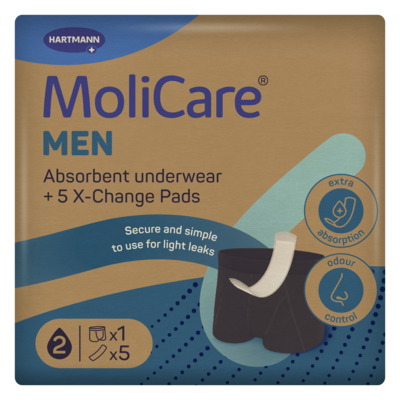 MoliCare® MEN Absorbent underwear + 5 X-Change Pads
<h3><strong>Men's washable incontinence pants with an invisible pad for extra protection</strong></h3>
<p>Feel confidently fresh all day with MoliCare® MEN Absorbent underwear with X-Change Pads. <br />
A discreet, simple-to-use solution for very light bladder weakness. Thanks to a special hidden pocket inside the underwear, you can easily insert a MoliCare X-Change Pad for extra protection which stays securely in place and is invisible. Just look for the layer of extra fabric inside the underwear and slip the pad into it for increased absorbency and security.<br />
With 4 layers of protection and a special leakproof technique MoliCare® MEN Absorbent underwear with X-Change Pads is designed to keep you feeling confident and dry for up to 12 hours*. The X-Change Pad converts liquid into gel to reliably lock away up to 25 teaspoons (approx. 125 ml) of urine and neutralise odours.<br />
The men’s washable incontinence pants are comfortable to wear and have a masculine, timeless design.<br />
Indistinguishable from normal underwear, 83%** of men say the product is a convincing alternative to conventional disposable products. There’s no need to change your underpants throughout the day, simply replace the exchangeable absorbent core whenever you need.<br />
*Hours will vary depending on amount of urine and individual bladder habits.<br />
**Internal test at Paul Hartmann AG, 12/2023, Top 2 Box, n= 16 men, Germany </p>
MoliCare® MEN Absorbent underwear + 5 X-Change Pads
<h3><strong>Men's washable incontinence pants with an invisible pad for extra protection</strong></h3>
<p>Feel confidently fresh all day with MoliCare® MEN Absorbent underwear with X-Change Pads. <br />
A discreet, simple-to-use solution for very light bladder weakness. Thanks to a special hidden pocket inside the underwear, you can easily insert a MoliCare X-Change Pad for extra protection which stays securely in place and is invisible. Just look for the layer of extra fabric inside the underwear and slip the pad into it for increased absorbency and security.<br />
With 4 layers of protection and a special leakproof technique MoliCare® MEN Absorbent underwear with X-Change Pads is designed to keep you feeling confident and dry for up to 12 hours*. The X-Change Pad converts liquid into gel to reliably lock away up to 25 teaspoons (approx. 125 ml) of urine and neutralise odours.<br />
The men’s washable incontinence pants are comfortable to wear and have a masculine, timeless design.<br />
Indistinguishable from normal underwear, 83%** of men say the product is a convincing alternative to conventional disposable products. There’s no need to change your underpants throughout the day, simply replace the exchangeable absorbent core whenever you need.<br />
*Hours will vary depending on amount of urine and individual bladder habits.<br />
**Internal test at Paul Hartmann AG, 12/2023, Top 2 Box, n= 16 men, Germany </p>
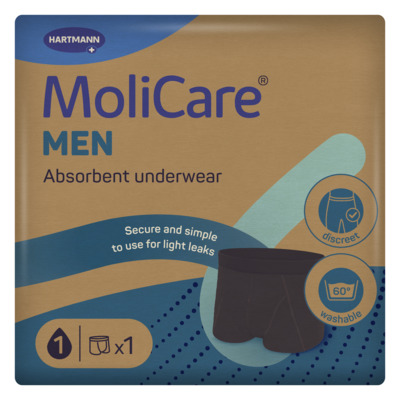 MoliCare® MEN Absorbent underwear
<h2><strong>Protective underwear for drips and dribbles in men</strong></h2>
<p>Get protection for men without the need for pads with MoliCare<sup>®</sup> Men Absorbent underwear. </p>
<p>Offering reliable leak protection, this washable men's underwear securely locks away urine thanks to its quick-dry technology. They look and feel exactly like your regular men’s boxers but with the subtle difference that they can hold up to 10 teaspoons of urine (50 ml). </p>
<p>Designed in Germany, MoliCare<sup>®</sup> Men underwear is dermatologically tested, free of harmful substances and Oeko-Tex 100 certified. Wash this men’s underpants for incontinence at 60° Celsius and use them again and again. </p>
<p><strong>Who is MoliCare<sup>®</sup> Men Absorbent underwear suitable for? </strong></p>
<p>MoliCare<sup>®</sup> Men underwear is for men who experience very light bladder weakness, resulting in small drops of spontaneous urine loss. The invisible men's bladder weakness pants are washable even at 60° Celsius, eliminating odour-causing bacteria.</p>
<p>Designed to look and feel like your normal underwear, they’re easy to put on and off.</p>
<h2><strong>Reusable and convenient solution for drips and dribbles</strong></h2>
<p>Don’t worry about dribbling after urination anymore. MoliCare<sup>®</sup> Men Absorbent underwear are discreet, washable men’s incontinence briefs offering a sustainable, comfortable and skin-friendly alternative to other hygiene products.</p>
<p>Indistinguishable from normal underwear, 87%* of men say the product is a convincing alternative to conventional disposable products.</p>
<p>Free of harmful substances, washable at 60° Celsius and suitable for tumble drying, MoliCare<sup>®</sup> Men Absorbent underwear combines leakproof protection and sustainability with a masculine, yet invisible design so no one will ever know you’re wearing washable incontinence pants. </p>
<p>* Internal test at Paul Hartmann AG, 12/2023, Top 2 Box, n= 16 men, Germany</p>
<p><strong>Caring for your reusable MoliCare<sup>®</sup> Men Absorbent underwear: a step-by-step guide</strong></p>
<ul>
<li>Wash before first use</li>
<li>Rinse out with cold water after use</li>
<li>Use a mild detergent to ensure underwear maintains its functionality. Do not use fabric softeners</li>
<li>Hygienically wash your MoliCare®Absorbent underwear at 60 °C</li>
<li>After washing you can tumble dry your underwear on a low heat</li>
<li>Following these steps will help your underwear stay fresh, clean and ready to wear</li>
</ul>
MoliCare® MEN Absorbent underwear
<h2><strong>Protective underwear for drips and dribbles in men</strong></h2>
<p>Get protection for men without the need for pads with MoliCare<sup>®</sup> Men Absorbent underwear. </p>
<p>Offering reliable leak protection, this washable men's underwear securely locks away urine thanks to its quick-dry technology. They look and feel exactly like your regular men’s boxers but with the subtle difference that they can hold up to 10 teaspoons of urine (50 ml). </p>
<p>Designed in Germany, MoliCare<sup>®</sup> Men underwear is dermatologically tested, free of harmful substances and Oeko-Tex 100 certified. Wash this men’s underpants for incontinence at 60° Celsius and use them again and again. </p>
<p><strong>Who is MoliCare<sup>®</sup> Men Absorbent underwear suitable for? </strong></p>
<p>MoliCare<sup>®</sup> Men underwear is for men who experience very light bladder weakness, resulting in small drops of spontaneous urine loss. The invisible men's bladder weakness pants are washable even at 60° Celsius, eliminating odour-causing bacteria.</p>
<p>Designed to look and feel like your normal underwear, they’re easy to put on and off.</p>
<h2><strong>Reusable and convenient solution for drips and dribbles</strong></h2>
<p>Don’t worry about dribbling after urination anymore. MoliCare<sup>®</sup> Men Absorbent underwear are discreet, washable men’s incontinence briefs offering a sustainable, comfortable and skin-friendly alternative to other hygiene products.</p>
<p>Indistinguishable from normal underwear, 87%* of men say the product is a convincing alternative to conventional disposable products.</p>
<p>Free of harmful substances, washable at 60° Celsius and suitable for tumble drying, MoliCare<sup>®</sup> Men Absorbent underwear combines leakproof protection and sustainability with a masculine, yet invisible design so no one will ever know you’re wearing washable incontinence pants. </p>
<p>* Internal test at Paul Hartmann AG, 12/2023, Top 2 Box, n= 16 men, Germany</p>
<p><strong>Caring for your reusable MoliCare<sup>®</sup> Men Absorbent underwear: a step-by-step guide</strong></p>
<ul>
<li>Wash before first use</li>
<li>Rinse out with cold water after use</li>
<li>Use a mild detergent to ensure underwear maintains its functionality. Do not use fabric softeners</li>
<li>Hygienically wash your MoliCare®Absorbent underwear at 60 °C</li>
<li>After washing you can tumble dry your underwear on a low heat</li>
<li>Following these steps will help your underwear stay fresh, clean and ready to wear</li>
</ul>
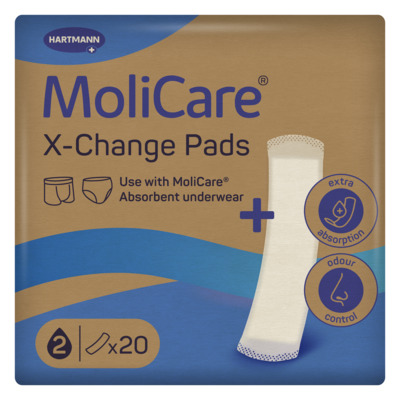 MoliCare® X-Change Pads
<h3><strong>Invisible underwear pads providing extra protection for MoliCare® Absorbent underwear</strong></h3>
<p>Enjoy that dry feeling for up to 12 hours* with MoliCare® X-Change Pads. <br />
Designed to add increased protection to MoliCare® Absorbent underwear, MoliCare® X-Change pads have a highly absorbent core that turns liquid into gel and neutralises unpleasant odours. The pad can hold up to 20 teaspoons (approx. 100 ml) of urine.<br />
Invisible due to the integrated pocket in MoliCare® Absorbent underwear, the pad stays in place and gives you the security of extra leakproof protection when you need it most. Just look for the extra layer of fabric inside the underwear and slip the pad into the pocket for increased absorbency and security against light bladder weakness. This unique concept is patented by HARTMANN.<br />
MoliCare® X-Change incontinence pads for underwear are easy to change and dispose of in public washrooms. Made to reduce disposable waste by 78 % compared to other incontinence products, they are free of silver chloride and other biocides that can have a negative impact on the intimate flora and environment.<br />
*Hours will vary depending on amount of urine and individual bladder habits.</p>
MoliCare® X-Change Pads
<h3><strong>Invisible underwear pads providing extra protection for MoliCare® Absorbent underwear</strong></h3>
<p>Enjoy that dry feeling for up to 12 hours* with MoliCare® X-Change Pads. <br />
Designed to add increased protection to MoliCare® Absorbent underwear, MoliCare® X-Change pads have a highly absorbent core that turns liquid into gel and neutralises unpleasant odours. The pad can hold up to 20 teaspoons (approx. 100 ml) of urine.<br />
Invisible due to the integrated pocket in MoliCare® Absorbent underwear, the pad stays in place and gives you the security of extra leakproof protection when you need it most. Just look for the extra layer of fabric inside the underwear and slip the pad into the pocket for increased absorbency and security against light bladder weakness. This unique concept is patented by HARTMANN.<br />
MoliCare® X-Change incontinence pads for underwear are easy to change and dispose of in public washrooms. Made to reduce disposable waste by 78 % compared to other incontinence products, they are free of silver chloride and other biocides that can have a negative impact on the intimate flora and environment.<br />
*Hours will vary depending on amount of urine and individual bladder habits.</p>
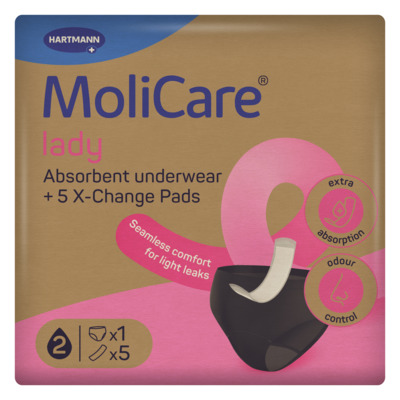 MoliCare® Lady Washable & Absorbent Underwear X-Change Pads
<h2>Why Choose MoliCare<sup>®</sup> washable bladder weakness underwear?</h2>
<p> </p>
<ul>
<li>Unique washable incontinence pants for ladies with a hidden pocket to insert MoliCare<sup>®</sup> X-Change Pads for extra protection</li>
<li>Versatile daily hygiene product for very light bladder weakness</li>
<li>In combination with the exchangeable X-Change Pads, these washable incontinence pants safely lock away up to 30 teaspoons (approx. 149 ml) of urine for a secure, dry feeling</li>
<li>Leakproof pant with a seamless and invisible design for maximum discretion</li>
<li>MoliCare<sup>®</sup> X-Change Pads provide reliable odour control and are easily inserted into the pants and changed as required</li>
<li>Hygienically wash the incontinence pants at 60°C, without the X-Change Pad</li>
<li>78% less plastic waste compared to conventional disposable incontinence products</li>
<li>Suitable for tumble drying</li>
<li>Free of silver chloride and other biocides that can negatively affect vaginal flora</li>
<li>Designed in Germany and made from soft, gentle-on-skin fabrics</li>
<li>This pack contains one pair of women's washable incontinence pants in Size M or Size L plus 5 X-Change-Pads</li>
<li>Designed in Germany and made from soft, gentle-on-skin fabrics</li>
<li>Medium size corresponds to EU size 40/42, or dress size 14-16</li>
</ul>
MoliCare® Lady Washable & Absorbent Underwear X-Change Pads
<h2>Why Choose MoliCare<sup>®</sup> washable bladder weakness underwear?</h2>
<p> </p>
<ul>
<li>Unique washable incontinence pants for ladies with a hidden pocket to insert MoliCare<sup>®</sup> X-Change Pads for extra protection</li>
<li>Versatile daily hygiene product for very light bladder weakness</li>
<li>In combination with the exchangeable X-Change Pads, these washable incontinence pants safely lock away up to 30 teaspoons (approx. 149 ml) of urine for a secure, dry feeling</li>
<li>Leakproof pant with a seamless and invisible design for maximum discretion</li>
<li>MoliCare<sup>®</sup> X-Change Pads provide reliable odour control and are easily inserted into the pants and changed as required</li>
<li>Hygienically wash the incontinence pants at 60°C, without the X-Change Pad</li>
<li>78% less plastic waste compared to conventional disposable incontinence products</li>
<li>Suitable for tumble drying</li>
<li>Free of silver chloride and other biocides that can negatively affect vaginal flora</li>
<li>Designed in Germany and made from soft, gentle-on-skin fabrics</li>
<li>This pack contains one pair of women's washable incontinence pants in Size M or Size L plus 5 X-Change-Pads</li>
<li>Designed in Germany and made from soft, gentle-on-skin fabrics</li>
<li>Medium size corresponds to EU size 40/42, or dress size 14-16</li>
</ul>
